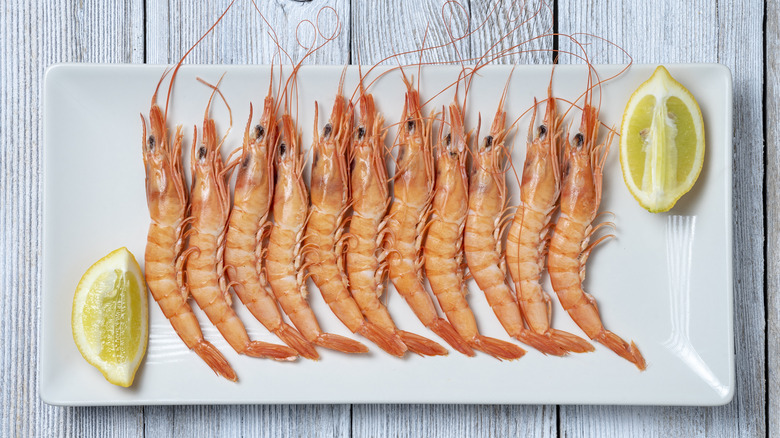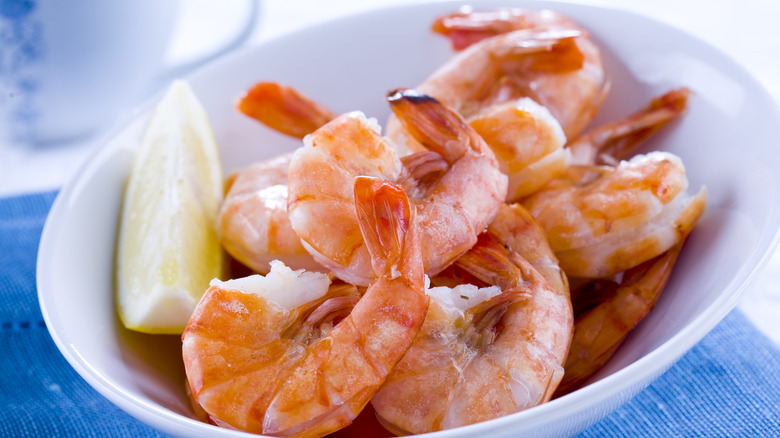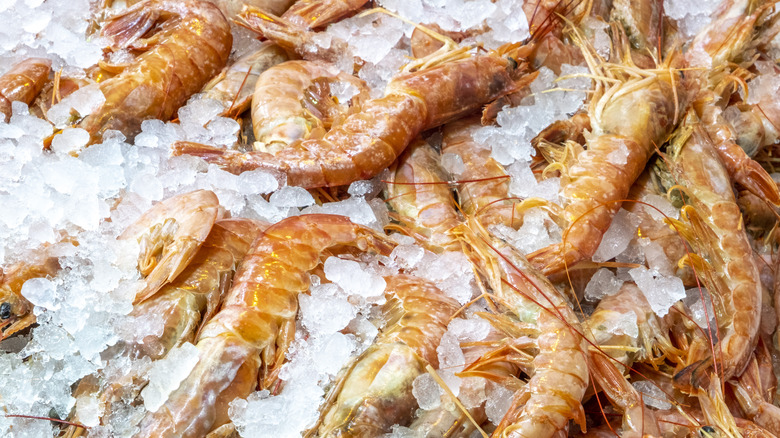There Is Actually A Difference Between Shrimp And Prawns
If you've ever used the words "shrimp" and "prawn" interchangeably, or if you thought that prawns are just large shrimp, then sorry to break it to you, but you've made a mistake. To be fair, it's not a heinous error, as these two types of crustaceans aren't too dissimilar, but they are separate species.
Let's break it down. In biological terms, both creatures belong to the same broad family of decapod crustaceans, meaning they're shelled marine creatures with ten legs. But within that, they belong to different suborders — shrimps are in the Pleocyemata suborder, and prawns in the Dendrobranchiata one. This means there are physical differences between the two. For example, prawns have six pincers (compared to two on shrimp), with a front pair that tends to be particularly large.
When it comes to dinner though, does anybody really care how many pincers these tasty guys have? Probably not. For the average shopper, the slight differences in size, shape, and a few other minor factors are probably more distinctive. But, they're still minimal enough that shrimps and prawns are mostly interchangeable when it comes to cooking.
Choosing between shrimp and prawns when cooking
When it comes to cooking and eating shrimp and prawns, these crustaceans are regarded as very, very similar, and the few distinctions that do exist don't have much effect on how you cook or eat them. For example, the shrimp we eat have usually been sourced from saltwater, while prawns are generally sourced from freshwater, although both crustaceans can live in either type of water. You might think that results in flavor differences (such as shrimp tasting more briny), but, that's not usually the case. Prawns are also sometimes perceived to be marginally sweeter, but realistically, you can use prawns in shrimp recipes and vice versa.
You could see a difference in flavor as a result of environmental factors, such as what the crustaceans eat or where they're raised, but the same could be said of most meat and seafood. For example, you'll probably get better quality if you buy wild crustaceans (as opposed to mass-farmed ones), and if you compare wild prawns to farmed shrimp (or vice versa), you may notice a difference in quality.
The other distinctions that might affect your choice to use shrimp or prawns in your recipes are their size and cost. Prawns tend to be larger (although not always), so choosing between the two may depend on whether you want to chow down on big or small pieces of shellfish. Shrimp are also generally a bit cheaper, so if you consider the near-identical taste, they may be a more economical option.
Other minor differences to know
It's also worth noting that you could find roe (that is, fish eggs) on store-bought shrimp, but you won't find that in prawns. This is because prawns release their eggs into the water, while shrimp carry them on their body. You can easily wash this roe away, but it is safe to eat and considered a delicacy in many cuisines.
There are some differences in shape, too: Because of their shells' more rigid structure, prawns have straighter bodies, while shrimp have more flexible shells that bend, so you're more likely to see them in a curved shape. This is primarily an aesthetic difference, but if you want your shellfish to lay flat so it cooks as evenly as possible, you might find yourself reaching for skewers to straighten out shrimp more often than with prawns.
Finally, there are a variety of linguistic quirks around the names "shrimp" and "prawn." For example, British people will often use "prawn" as a catch-all word for both creatures, while Americans will use "shrimp" in the same way. You'll also find that large shrimp are sometimes mistakenly labeled as prawns, due to the general belief that shrimp are smaller. Some varieties of shrimps and prawns are even named for the other species. Spot prawns, for example, are actually a type of shrimp while ridgeback shrimp are actually a type of prawn.
Thankfully, if you end up with prawns when you meant to buy shrimp (or vice versa), it's not likely to make much of a difference; you can cook them just as you planned and they should taste essentially the same.


